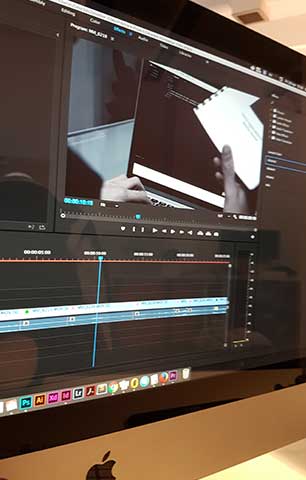There is a lot to consider when planning video marketing for your business; what risks are involved, what could it achieve, how and where could you use the video?
Video can be used on your website to tell people about your company; on your Home or About Us page, or used to introduce potential customers to your products or services. This can also have other great benefits such as improving your sites Search Engine Optimisation.
Videos can also be great content to share on social media to promote your business across platforms.
Video and Social Media
When it comes to trying to decide what you should be posting on social media, it is good to know about the kind of content people find stimulating – what catches their attention and makes them want to interact.
Facebook, Twitter, Instagram etc. all use algorithms to decide whose voice gets to be heard or whose photos or videos get to be seen. These algorithms look at how people interact with you, as a user and within the post itself – it is commonly said that video now has the highest rate of interaction than any other form of content.
Whilst images/graphics/photos can really help engagement, video can allow you to say much more and to capture your audience’s attention for much longer than a single image or a written message can.
Posting video on social media should help you to get more engagement from your followers. There is also the opportunity to use these videos in promoted/ paid for advertising with YouTube, Twitter and Facebook, which should then help to bring in more followers and expand your social following.
Video and SEO
As Google now knows that people like to watch videos, they want to show more of these in their results. The issue though is that Google cannot yet process the spoken words from videos in the same way it processes written content, so a useful point for your developers is to use Schema mark-up and closed caption subtitle files so that the video is readable and Google will be able to tie the video to related searches.
Ever since the 2013 Google search algorithm update – Hummingbird –, we have known that Google prizes “quality content” over keyword optimisation. One marker of great content is the interaction rate. If a video is regularly being watched from start to finish on your site or even shared from your site to social media, then Google would see this engagement, which should result in better positioning in the search engine results page (SERP).
A great video should encourage people to spend longer on your website (which is great for SEO) and more time interacting with your brand – and should hopefully encourage them to take action.
Style and Substance
Before you start creating your video, you want to make sure you think about your target market and what is going to appeal to them, along with what you want the video to say about your company – plan the tone of voice, style and the content of your video.
Timing is everything
There’s no time to waste. Keep your videos to around 1- 2 mins long. If people watch it all the way through then this is a good signal to the platform, and Google if it’s on your website, that the content is interesting or entertaining to viewers.
The video will also need to connect with the viewer almost immediately so should quickly be compelling and show personality.
Comical or informative?
When planning what kind of video to make – think carefully! There are many examples of companies who have accidentally offended their potential customers during their attempt at promoting themselves – and it’s not just the video marketing campaigns that get bad press that can be considered fails. On YouTube there are endless companies who have made videos that (even if how cheesy they are actually makes them entertaining!) will have in no way led the company to making any sales.
There’s no doubt that there can be huge rewards for creating ‘viral’ type videos, and Forbes have some tips on how to make videos go viral if you are wanting to know more about this.
But, there can also be great value in creating content which isn’t trying to be funny or go viral. Videos which give genuine insight into your business and show your brand, products / services or promotional offers, can be very useful in helping customers understand your business and help increase trust. Examples of these could be; quick behind the scenes videos of your company, your products being made, customers enjoying your service, interviews with employees or customers, short animations etc. 52% of consumers say that watching a video makes them more confident in online purchases (Inovodo), and Axonn Research found seven in 10 people view brands in a more positive light after watching interesting video content from them.
You can also go down the route of being Informative and addressing an issue. For this, think about what problems or obstacles your clients could be facing and answer them in your video.
YouTube and beyond
Don’t just post your videos on YouTube. You Tube is just a small part of video marketing – yes it’s handy for hosting but it’s essentially just an advertising platform for Google, where Google uses your content to make them revenue. If people do see your video on YouTube, they are then shown related videos and these will probably be from your competitors.
On YouTube people are not looking to buy or for services, they are “discovering”. They are extremely unlikely to click to visit your website, with the click through rate from YouTube to a website being around 1%. Just posting your video on YouTube and expecting this to turn into business won’t work.
Instead upload the video directly onto your website and share this on Twitter, Instagram, Facebook and YouTube. This is all about owning your own content. You want people to be on your site, as this is the way you will get business.
You can use the video hosting platform WISTIA which will let you embed 5 videos on your site using their program for free. WISTIA allows you to add custom text box annotations, link to other pages on the website, capture emails, and probably most significantly there are no ads or links to other videos or competitors at the end of the video, allowing you to end with a clickable call to action.
What now?
You need to think about what you want the viewer to do after seeing your video and ensure you’ve clearly shown how they should contact you or buy your product, especially if you are using Youtube rather than WISTIA or something similar to host the video on your site. Here’s some ideas for how you can display these call to actions:
- In the same way that TV ads have information at the end of the advert telling you how you can buy the product or get in touch, a video marketing video can do the same, with text overlaid on the video and/or a voice explaining what to do.
- Include a clear call to action in the navigation, as we have with our ‘REQUEST A QUOTE’.
- Have a button under the video taking viewers to where you want them to go next. For example, linking to a registration form with a button saying ‘Give it a try’.
- As an extra measure, you could also have text beside or underneath the video with hyperlinks that take the viewer to the desired pages. (It’s also a good idea to have some text above the video to entice the user to watch the video in the first place).
- If you are selling products, you could have images of the products featured in the video beneath and link these to their product pages, where people can then purchase these products.
Success
Of course the success of the video depends on its appeal, the reach of the video within the budget and how well it is targeted, so it is important with a campaign like this to ensure that you have clear goals set out and that you measure the successfulness of the campaign. You can then use this data to help you make decisions about any further video promotions.
If you would like help promoting your video in social media and/or with paid for advertising, or help making the most of video on your site, get in touch.

